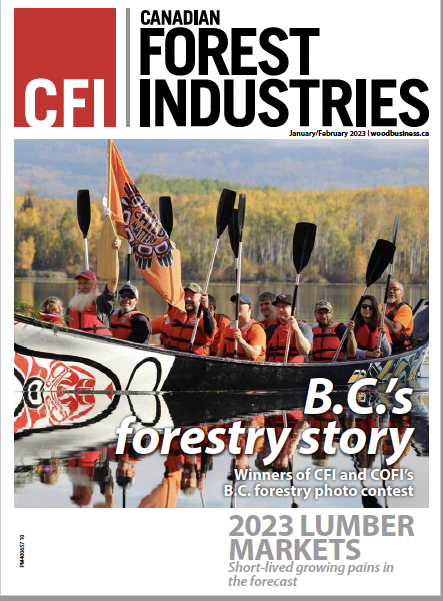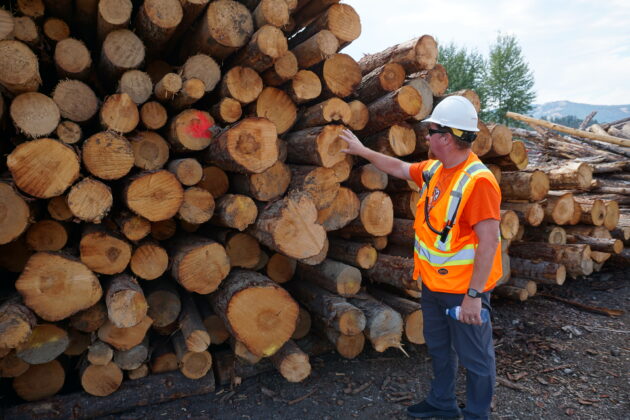
Features
Opinions
Year of the Rabbit: Can we expect a bounce? Plus, CFI’s latest issue out now!
The problem of the lack of economic fibre in B.C. must be addressed, stat
February 10, 2023 By Jennifer Ellson
 CFI's January/February issue is now available.
CFI's January/February issue is now available. What a start to the new year! Ushering in 2023 was a barrage of more curtailment and closure announcements from several B.C. forest products companies that started to shutdown operations late last year. Sawmills, pulp and paper facilities and biomass plants are all affected and the reasons being given are all the same: lack of economic fibre and weak market conditions.
It’s very hard to keep track of the closures, but in this issue, we created a table to show the list of Canadian mills that shuttered operations temporarily or permanently as of mid-January.
Among those on the list, it was Vaagen Fibre Canada’s indefinite closure that hit me the most because I visited the facility in Midway, B.C., last summer and interacted with employees who were very proud of the work they did and what they had accomplished. I wrote about that visit for this issue, and how the local community of 650 residents can possibly help get the mill out of the woods.

Vaagen Fibre manager Dan MacMaster showing CFI around the Midway, B.C., facility in August 2022. Photo: Annex Business Media.
Sure, government relief is on the way. In fact, both the federal and the B.C. governments have announced new funding: a combined $18.8 million to retool Paper Excellence’s shuttered Crofton mill to manufacture new pulp products. Another $90 million from the province will be invested over three years to help transition struggling forestry communities. B.C. Premier David Eby said the new funds will “diversify local economies, promote value-added innovation in the forestry sector and create thousands of good-paying jobs.”
But with the lack of economic fibre, how far can these value-added innovations go? Where is the economically available raw material coming from to add value to? In my conversations with industry players: sawmillers, loggers, suppliers, they all point to the fact that the B.C. government must first address the biggest challenge facing the B.C. segment: the lack of a reliable supply of fibre. Companies will not invest in B.C. unless there is a clear plan to address this problem. Take Canfor for example – the company has shuttered some of its B.C. facilities both temporarily and permanently, but last year, it announced a $210 million investment in Alabama to build a sawmill with an annual production capacity of 250 million board feet. In fact, Canadian forestry giants – some of which are B.C.-based – have been investing in the U.S. South for years. Of course there’s a lot of reasons for this, but the key factors are the availability of economic fibre in that region, as well as the tariffs levied on Canadian softwood lumber.
Around the same time last year, the headlines were about the deferral of old-growth logging in B.C. and policy changes to the forest tenure system. Not surprisingly, the lack of access to fibre dominates the headlines these days due to the dramatic drop in the supply of logs from various factors such as wildfires, mountain pine and spruce beetle infestations, as well as the policy changes.
Yes, help is on the way: Premier Eby announced a $50 million funding to be used for projects and programs that increase the use of low-value or residual fibre, including trees damaged by recent wildfires and waste left over from logging that would otherwise be burned in slash piles. That’s a start. But more is needed to be done.
Now I am not one to believe in astrology, but on the Lunar New Year, Jan. 22, the Year of the Rabbit began, and I would like to believe in the lucky rabbit. Indeed, the rabbit is said to be one of the luckiest animals on the Chinese zodiac, as it symbolizes abundance, and it lives in harmony with nature. How appropriate for the forest industry! In this year of the hare, can the forest sector pull a rabbit out of the hat and bounce from the current challenges? Forest Economic Advisors’ Paul Jannke has some answers in his 2023 lumber markets outlook. Short-lived growing pains are in the forecast, he says, but there’s optimism on the horizon.
We said goodbye to the Year of the Tiger in 2022, which was a fierce one indeed for the forest sector. Traditionally, the Year of Rabbit is said to be a gentler year. Now that’s something worth believing. So let’s all hope that the industry will find its rabbit footing this year and be able to leap forward.
Read the January/February issue now!
Print this page